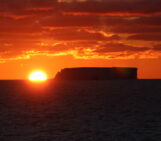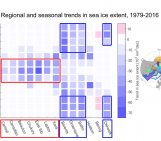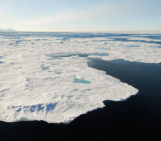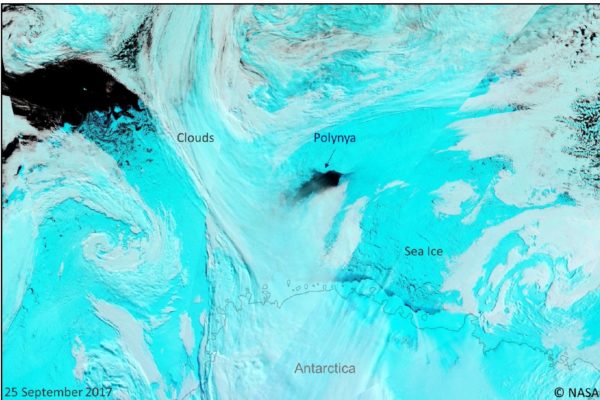
The mysterious appearance and disappearance of the Weddell Polynya, a giant hole in the sea ice cover, has long puzzled scientists. Recent work reveals that the polynya is initiated and maintained by gigantic and formidable atmospheric currents: atmospheric rivers! Read on to find out more…
Each year, approximately 15 million square kilometers of ice forms in the Southern Ocean around Antarctica during the austral winter, and subsequently melts during the following austral summer. Within the sea ice zone, recurring and persistent regions of open water are known as polynyas. Their spatial extent is on the order of tens of thousands of square kilometers and they usually occur at specific locations, as if some oceanic regions were more easily susceptible to them. For marine ecosystems, they constitute recurring “open water windows” in the sea ice cover and represent ecologically important “oases” that enable marine life to overwinter at high latitudes, and encourage primary biologic production in the spring.
Around Antarctica, most of the polynyas occur near the coast – when strong continental winds push the ice away from the coast- except a few, such as the Weddell Polynya, which occur within the sea ice cover of the eastern Weddell Sea in certain winters (Figure 1). In particular, the Maud Rise seamount (centered on 66°S and 3°E and reaching 1200 m below the sea surface) is a prominent sea floor feature of the Weddell Sea, which brings relatively warm water to the surface via deep convection due to its rough bathymetry interacting with the ocean currents. This provides an ideal setting for the initialization of a polynya further away from the coast.
The Weddell Polynya was observed for the first time in 1974, and its second major opening occurred in September 2017. In those years, its maximum spatial area varied between ~200,000 and 300,000 square kilometers (Figure 2).
The Weddell Polynya is a rather famous sea ice free hole in the ice. Scientists have been investigating polynya in the Southern Ocean for decades, but mainly focusing on the influence of the ocean on their openings. But the true reasons for the appearance and disappearance of the Weddell Polynya were still surrounded by mystery – until very recently – when the role of the atmosphere and atmospheric rivers was brought under the spotlight.
What are atmospheric rivers?
Atmospheric rivers are stretched cloud bands and narrow corridors of water vapor transported from the tropics to the poles (Figure 3). They are associated with a low-level jet stream (high altitude fast flowing winds) and form sometimes ahead of extra-tropical cyclones. In both hemispheres, atmospheric rivers are believed to account for more than 90% of the annual moisture transport from the tropics into the high latitudes, despite their relatively short duration (a few days) and extent which involves only 10% of the globe’s surface.
In polar regions, the activity of atmospheric rivers has been increasing in recent years and is projected to increase even more under a warmer climate. The ability of such atmospheric rivers to rapidly transport large amounts of moisture and heat pole-ward has significant consequences for both land-ice and sea-ice. They have a big role in short-lived but high-volume melting events over the Arctic and the Antarctic, as shown in recent studies (e.g., Mattingly et al., 2018). It has been shown that atmospheric rivers increase ice melt through several mechanisms: the transport of heat from lower latitudes, the increase of cloud cover which favors the re-emission of infrared radiations to the surface, the release of heat because of water condensation, the precipitation of rain in place of snow, to cite just a few.

Figure 2: Cloud bands associated with ARs on 13 September 2017 (A) and on 16 September 2017 (B). The location of the polynya is indicated by the letter P and atmospheric rivers by AR on these two panels. The large Weddell Polynya opening on 23 September 1974 (C), which initially opened on 22 November 1973 and remained open for the following three winters and the second opening of the Weddell Polynya that occurred in September 2017 (D). Figure credits: the European Organization for the Exploitation of Meteorological Satellites; Francis et al., (2020).
Why does the Weddell Polynya form?
Various processes have been proposed to explain the sustained formation of the Weddell Polynya. All involve the complex interaction of the atmosphere, ocean, sea ice and seabed. These processes include the role of the disturbance of the oceans’ surface due to severe storms and the upwelling of warm waters.
But an additional important factor that has been neglected in the formation of polynya is the role of atmospheric rivers. This was the focus of our new study, which investigated the relationship between the opening of the Weddell Polynya and the occurrence of atmospheric rivers.
Using satellite observations and reanalysis data, we found that in some winters, atmospheric rivers moved a significant amount of heat and moisture from the tropics/mid-latitudes to Antarctica (Figure 2). A few days before the Weddell Polynya openings of 1973 and 2017, persistent atmospheric rivers were observed, maintaining a sustained high transport of heat and moisture. These particular conditions led to a strong warming of the sea surface (about +10°C), resulting in sea ice melt and the inhibition of night-time refreezing.
We had previously highlighted that strong cyclones were at the origin of the formation of the Weddell Polynya (Francis et al., 2019). Indeed, when cyclones form and spin over the ice pack, they drag the floating sea ice away from their center, favoring the opening of the sea-ice cover. Our new study found that this would not have been possible without the help of atmospheric rivers. Their occurrence is in fact necessary to weaken the sea ice before the passage of the cyclones.
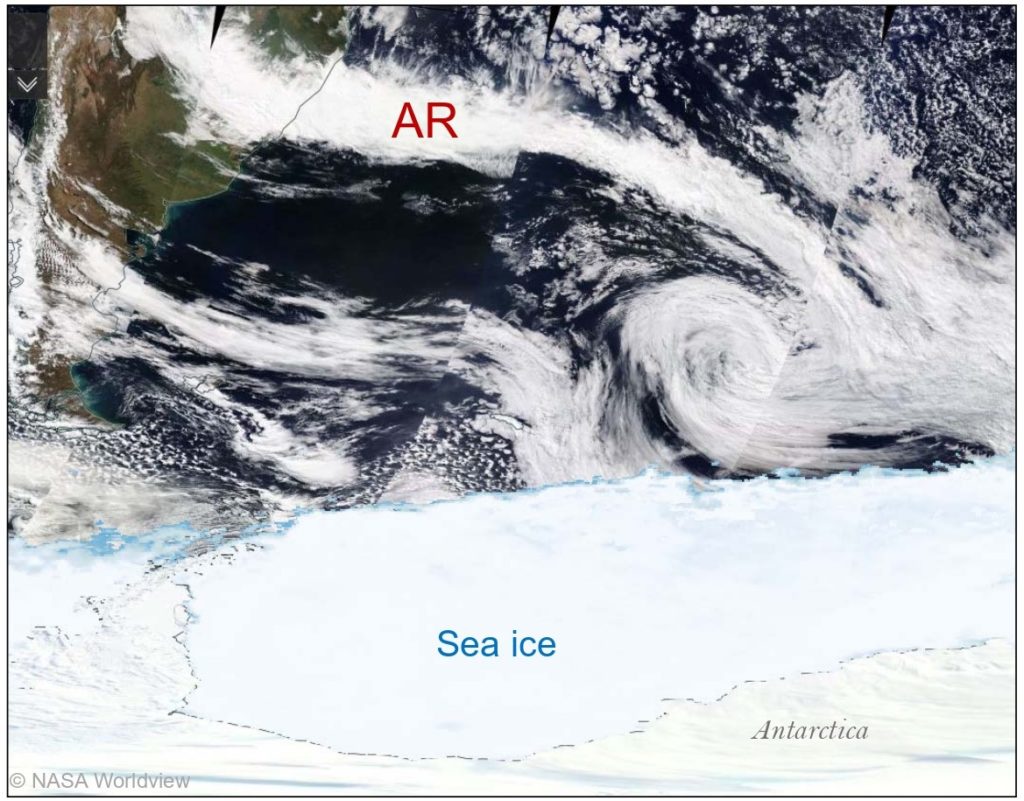
Figure 3: An atmospheric river (AR) stretching from Southern America towards the Weddell Sea in Antarctica on September 16, 2017, as captured by the Moderate Resolution Imaging Spectroradiometer (MODIS) on NASA’s Terra satellite. The sea ice concentration and extent in the Weddell Sea are superimposed on the map (light blue shade) and are derived from satellites. Figure credit: NASA Worldview.
Why does the Weddell Polynya matter?
Once opened, a polynya works like an open window through the sea ice during winter. By virtue of its vast size and its location, the Weddell Polynya makes a major contribution to the wintertime transfer of heat and moisture between the ocean and the atmosphere, allowing for the ventilation of deep ocean portions through upwelling. In doing so, it strongly modulates oceanic and atmospheric properties and circulation, with effects on oceanic bio-productivity and carbon uptake, which have implications for wider sectors of the Southern Ocean.
Given these factors, there is a strong motivation to better understand and model the nature and drivers of the Weddell Polynya openings. In particular, it will be important to assess and predict whether these rare but important events, will occur more or less frequently in a warming climate.
What might happen in the future?
Under projected future climate change, the occurrence of atmospheric rivers is predicted to increase by ~50% globally and by ~60% in the southern mid-latitudes. It is also anticipated that atmospheric rivers will become longer and wider, thus transporting more heat and moisture toward the Antarctic region, with consequences on both sea-ice and land-ice. This will not only affect the cryosphere, but also the atmosphere, the oceans and very likely the ecosystems of the Southern Ocean.
I guess that now you can understand why we need to learn more about how atmospheric rivers develop and what is their role in the climate of the Southern Ocean.
Further Reading
- Francis D., K. S. Mattingly, M. Temimi, R. Massom, P. Heil (2020). On the crucial role of atmospheric rivers in the two major Weddell Polynya events in 1973 and 2017 in Antarctica. Sci. Adv. 6, eabc2695, https://advances.sciencemag.org/content/6/46/eabc2695.
- Francis D., C. Eayrs, J. Cuesta, D. Holland (2019). Polar cyclones at the origin of the reoccurrence of the Maud Rise Polynya in austral winter 2017, Journal of Geophysical Research: Atmospheres, 124. DOI: 10.1029/2019JD030618
- Barber, D.G. and R.A. Massom (2007). Chapter 1 The Role of Sea Ice in Arctic and Antarctic Polynyas, Elsevier Oceanography Series, 74, pp. 1-54. DOI: 10.1016/S0422-9894(06)74001-6
- Cheon, W.G., Gordon, A.L. (2019) Open-ocean polynyas and deep convection in the Southern Ocean. Sci Rep 9, 6935. DOI: 10.1038/s41598-019-43466-2
- Mattingly K. S., T. L. Mote, X. Fettweis (2018). Atmospheric river impacts on Greenland Ice Sheet surface mass balance. J. Geophys. Res. Atmos. 123, 8538–8560, DOI: 10.1029/2018JD028714
Edited by Giovanni Baccolo and Marie Cavitte
 Diana Francis is a Senior Scientist at Khalifa University, Abu Dhabi, UAE. She investigates atmospheric dynamics in polar regions with focus on polar meteorology and links to changes in land and sea ice conditions. To this end, she uses regional models together with available observations and reanalyses. She tweets as @drdianafrancis. Contact Email: diana.francis@ku.ac.ae
Diana Francis is a Senior Scientist at Khalifa University, Abu Dhabi, UAE. She investigates atmospheric dynamics in polar regions with focus on polar meteorology and links to changes in land and sea ice conditions. To this end, she uses regional models together with available observations and reanalyses. She tweets as @drdianafrancis. Contact Email: diana.francis@ku.ac.ae

